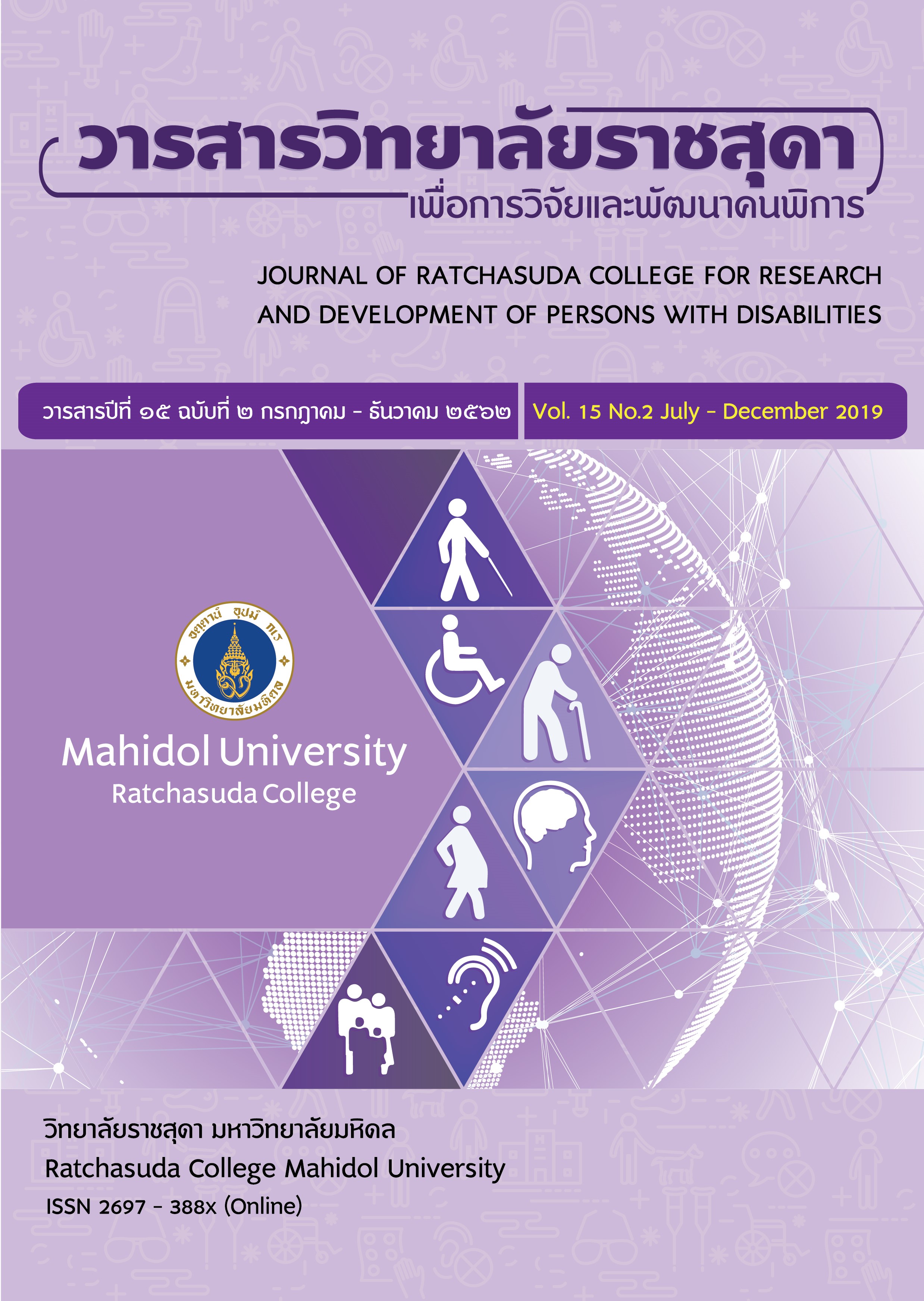สภาพปัจจุบัน จุดแข็ง จุดอ่อน โอกาส และอุปสรรคของการจัดการเรียนการสอน ของโรงเรียนโสตศึกษาจังหวัดร้อยเอ็ด
คำสำคัญ:
สภาพปัจจุบัน, จุดแข็ง จุดอ่อน โอกาสและอุปสรรค, การจัดการเรียนการสอน, โรงเรียนโสตศึกษาบทคัดย่อ
กาวิจัยเรื่องนี้มีวัตถุประสงค์เพื่อ 1) ศึกษาสภาพปัจจุบันของการจัดการเรียนการสอน และ 2) วิเคราะห์จุดแข็ง จุดอ่อน โอกาส และอุปสรรคของการจัดการเรียนการสอน โดยการวิจัยเชิงคุณภาพ (Qualitative Research) ผู้ให้ข้อมูล คือ ครูผู้สอน จำนวน 6 คน ผู้วิจัยเลือกผู้ให้ข้อมูลแบบเจาะจง (Purposive Sampling) เก็บรวบรวมข้อมูลโดยการสนทนากลุ่ม (Focus Group) และการสัมภาษณ์เชิงลึก (In-depth Interview) เครื่องมือวิจัย คือ แบบการสนทนากลุ่ม (Focus Group Form) และแบบการสัมภาษณ์เชิงลึก (In-depth Interview Form) วิเคราะห์ข้อมูลโดยใช้โปรแกรม ATLAS.ti ผลการวิจัยปรากฏดังนี้
1) สภาพปัจจุบันของการจัดการเรียนการสอน พบว่า โรงเรียนจัดการสอนแบบปรกติโดยใช้หลักสูตรแกนกลางของกระทรวงศึกษาธิการ และการสอนแบบวอลดอร์ฟ (Waldorf) ครูสอนโดยใช้ภาษามือ สอนแบบองค์รวม การใช้รูปภาพ บทบาทสมมติ และวิดีโอประกอบการสอน โรงเรียนสนับสนุนงบประมาณการผลิตสื่อการสอนแก่ครู 2) จุดแข็ง พบว่า โรงเรียนมีการวางแผนการจัดครูประจำชั้น ครูมีความสามารถในการจัดทำหลักสูตร สถานศึกษา และหลักสูตรรายวิชา โรงเรียนจัดอบรมและทดสอบภาษามือแก่ครู ครูนำกระบวนการวิจัยมา แก้ปัญหาการเรียนการสอน ครูใช้
วิธีการสอนแบบบูรณาการ และโรงเรียนอำนวยความสะดวกด้านอุปกรณ์การสอนแก่ครู จุดอ่อน พบว่า งบประมาณการผลิตสื่อการสอนไม่เพียงพอ ครูขาดความเชี่ยวชาญด้านการวิจัย และด้านการใช้เทคโนโลยี โอกาส พบว่า ประเทศไทย
มีการส่งเสริมการศึกษาสำหรับนักเรียนที่มีความบกพร่องทางการได้ยิน โดยหน่วยงานภาครัฐให้การช่วยเหลือ และมอบสิ่งอำนวยความสะดวกในการจัดการศึกษา และชุมชนมีส่วนร่วมในการจัดการศึกษา อุปสรรค พบว่า นโยบายการจัดการศึกษายากต่อการนำมาปฏิบัติจริง หลักสูตรการสอนไม่สอดคล้องกับความสามารถในการเรียนรู้ของนักเรียน
และข้อจำกัดของคำศัพท์ภาษามือทางวิชาการไม่ครอบคลุมในรายวิชา
Downloads
เอกสารอ้างอิง
Chaiwatthanakunwanit, S. (2013). Development of An Alternative Educational Provision model to Improve Quality of Life of Children with Special Needs : A Case Study of Hearing Impaired Children. (Doctoral dissertation). Chulalongkorn University, Bangkok,Thailand.
Chandee, S. (2011). Learning framework for hearing impaired students. (Doctoral dissertation). King Mongkut’s University of Technology Thonburi, Bangkok, Thailand.
Chansongsaeng, W. (2006). The sound from the world is silent. Bangkok, Samlada Press.
Daocharoen, T. (2016). The Accessibility to Social welfare for Hearing Disability People in Amphoe Thamaka Changwat Kanchanaburi. (Master’s thesis). Silpakorn University, Bangkok, Thailand.
Ghulam Fatima, Abid Hussain Ch., & Misbah Malik. (2016). Instructional Practices used by Special Education Teachers in Classrooms of Young Children with Deafness. Bulletin of Education and Research, 38(1), 90-91.
Ministry of Education. (2015). Education Provision for Persons with Disabilities Act B.E.2008. Bangkok, Khurusapha Press.
Ministry of Education. (2009). National Education Act B.E. 1999 and Amendments (Second National Act. B.E.2002) and Thired National Education Act B.E.2010. Bangkok, Kurusapha Press.
Office of the Education Council. (2017). National Education Plan 2017-2036. Bangkok Press.
Parker, A.T. and Catherin Nelson. (2016). Toward a Compehensive System of Personal Development in Deafblind Education. American Annals of the Deaf, 164(4), 487-488.
Patjan, S. (2014). The Phenomenal Characteristics of Factors on the Sign Language Learning of Elementary Hearing Impaired Students. (Master’s thesis). Burapha University, Chonburi, Thailand.
Pizzo, L. (2013). Vocabulary instruction for the development of American sign language in Deaf children: An investigation into teacher knowledge and practice. (Doctoral dissertation). Boston College, Chestnut Hill Massachusetts, America.
Special Education Training package. (2010). The Project to upgrade the quality of teachers throughout the system according to the Thai Khem Khaeng Action Plan. Chulalongkorn University Press.
Sriorn, C. (2007). Reading ability and writing Thai language for students with hearing impaired, grade 6. (Master’s thesis). Mahidol University, Bangkok, Thailand.
Thamsaeng, M. (2011). Language teaching methods for deaf children. Setsatian School for the Deaf under the Royal Patronage of his Royal highness Crown Prince Maha Vajiralongkorn Press.
The National Deaf Children’s Society. (2004). Deaf friendly teaching. London: The National Deaf Children’s Society. ไม่ปรากฏสถานที่พิมพ์
Thirachit, W. (2002). Education for the Exceptional Children (3nd ed.). Chulalongkorn University Press.
Wanwichai, R. (2011). A Study of Thai Dance Teaching and Learning Environment for The Deaf Students in The Special Education School in Central Area. Srinakharinwirot University Press.
ดาวน์โหลด
เผยแพร่แล้ว
รูปแบบการอ้างอิง
ฉบับ
ประเภทบทความ
สัญญาอนุญาต
บทความที่ได้รับการตีพิมพ์เป็นลิขสิทธิ์ของวารสารสถาบันราชสุดาเพื่อการวิจัยและพัฒนาคนพิการ






